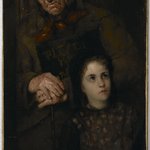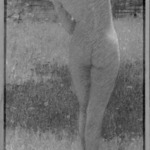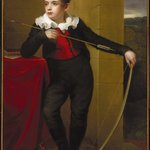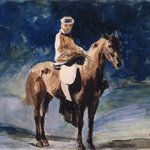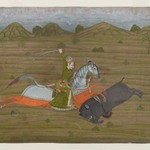

Kehinde Wiley (American, born 1977). Napoleon Leading the Army over the Alps, 2005. Oil on canvas, 108 x 108 in. (274.3 x 274.3 cm). Brooklyn Museum, Partial gift of Suzi and Andrew Booke Cohen in memory of Ilene R. Booke and in honor of Arnold L. Lehman, Mary Smith Dorward Fund, and William K. Jacobs, Jr. Fund , 2015.53. © artist or artist's estate (Photo: Brooklyn Museum, 2015.53_framed_PS2.jpg)

Kehinde Wiley (American, born 1977). Napoleon Leading the Army over the Alps, 2005. Oil on canvas, 108 x 108 in. (274.3 x 274.3 cm). Brooklyn Museum, Partial gift of Suzi and Andrew Booke Cohen in memory of Ilene R. Booke and in honor of Arnold L. Lehman, Mary Smith Dorward Fund, and William K. Jacobs, Jr. Fund , 2015.53. © artist or artist's estate (Photo: Brooklyn Museum, 2015.53_cropped_PS2.jpg)
Napoleon Leading the Army over the Alps
Kehinde Wiley
Contemporary Art
On View: Martha A. and Robert S. Rubin Pavilion, 1st Floor
In 2005, Wiley created the Rumors of War series: a group of four monumental paintings, including Napoleon Leading the Army over the Alps, depicting military men on horseback. The series responds to the United States’ involvement in the Middle East under the presidency of George W. Bush. The Iraq War, which had begun as a search for weapons of mass destruction, resulted in the capture of Iraqi dictator Saddam Hussain and the discovery of incidents of torture and abuse of Abu Ghraib detainees by members of the U.S. Army.
Rumors of War also includes Wiley’s interpretaton of equestrian portraits by three other iconic European masters: Charles Le Brun (1619–1690), Peter Paul Rubens (1577– 1640), and Diego Velázquez (1599–1660). Unified by their identical gold frames, three of the paintings portray individual mounted subjects, while the fourth, modeled on Le Brun’s Chancellor Séguier (circa 1661), shows the mounted figure accompanied by a procession of six attendants on foot. One of them, a man in military camouflage, also appears in Napoleon Leading the Army over the Alps. In each painting, Wiley maintains the sitter’s pose from its source image, but he replaces the background with a decorative motif, creating an ambiguous sense of the subject’s location in space and time. The long tradition of the equestrian portrait plays into Wiley’s fascination with the concept of empire and its association with colonialism, political domination, and the abuse of power that frequently accompanies absolute control. As Wiley explains, “In these paintings . . . I’m demanding that we see and take seriously what heretofore had been considered marginal voices—when the peripheries become the center.”
"The scale of man to horse is a complete fiction. Men look a lot smaller on real horses. . . . All those grand tableaux that you see on the walls of the Louvre are propaganda. They are designed to complete the narrative of domination of empire and control."
Napoleon Leading the Army over the Alps is emblematic of Wiley’s long-standing and complicated engagement with the grand tradition of European history and portrait painting. Simultaneously “drawn toward that flame and wanting to blow it out,” Wiley’s work reflects his profound understanding of portraiture’s ability to construct images that convey the power of the sitter and to highlight the fact that he and other brown and Black people have been written out of this historical narrative. Through his work, he redresses this omission, offering a counter narrative.
Wiley’s involvement in the visual arts began in Los Angeles, where he was introduced to the Huntington Library, Art Museum, and Botanical Gardens, renowned for its collection of eighteenth- century British portraiture. During his visits with the local arts program, he closely observed the technical aspects of oil painting and the role that elegant attire and worldly possessions play in signaling wealth and power in the many depictions of European aristocrats. Wiley also noticed that people who look like himself were not the subjects of these portraits.
Wiley received his M.F.A. from the Yale School of Art in 2001 and moved that fall to New York City, where he had been awarded a place in the Studio Museum in Harlem’s Artist-in-Residence program. While walking down a street near the museum, he came across a crumpled New York City Police Department mug shot of a young Black man. Wiley took the page back to his studio and pinned it to the wall. Unlike the eighteenth-century portraits he had previously encountered, where the sitters possessed the power—often related to their race and class—to present themselves in what the artist describes as “states of stately grace,” the mug shot became emblematic of a kind of portraiture in which the subjects have no control over their own depiction. This led to what Wiley called “street casting” and the Passing/Posing series, where he invited young men he encountered on the street to pose for portraits. Working together with the artist, these strangers selected poses and gestures from reproductions of famous works of religious art from the Italian Renaissance, as well as from later European portraits. The Passing/Posing paintings set the stage for his subsequent bodies of work that, according to the artist, “quote historical sources and position young Black men within that field of ‘power.’”
"The goal of the painting is to engage the history of image-making, the history of power in image-making, and perhaps carve out space for people who don't often occupy that space."
This painting takes as its point of departure David’s iconic Bonaparte Crossing the Alps. In keeping with his practice, Wiley’s painting preserves the pose and composition found in David’s image, while swapping the heroic figure of Napoleon for a Black man, an everyday civilian in contemporary urban dress—camouflage pants, T-shirt, and Timberland boots—astride a rearing steed. The painting maintains the rocky outcropping in the foreground, inscribed with names of great historical military commanders, with the addition of the name WILLIAMS, the model’s last name. Aside from his last name, little else is known about the man sitting in the saddle, in contrast to the general whose role he assumes in the painting. In a marked departure, Wiley replaces the hazy blue sky in David’s painting with a rich red ground embellished with stylized floral motifs in gold. Jewellike gold sperm cells scattered across the painting’s surface make an unexpected reference to sexuality and masculinity. This motif reflects Wiley’s interest in what he calls hypermasculinity, as he associates the abundance of testosterone with aggression, military and otherwise. The sperm cells spill out onto the custom-made gold frame, adorning the testicular forms at each corner. Crowning the frame is a self-portrait of the artist emerging from the womb.
Wiley’s fascination with Napoleonic imagery extends to other examples of his work from the same year. For his portrait of the American rapper Ice-T, Wiley turned to Napoleon I on His Imperial Throne (1806), by David’s student Jean-Auguste-Dominique Ingres (1780–1867), to depict the musician wrapped with an ermine robe and holding a scepter.
In the context of French colonial history, Wiley’s Napoleon broadens the conversation about empire and domination. The artist’s strategy of drawing attention to the erasure of people of color from art history—in this case French history—brings to mind other histories of revolution from the nineteenth century. For one, it invokes the figure of Thomas-Alexandre Dumas, the highest-ranking Black general and Napoleon’s contemporary from the Caribbean. The work calls forth histories of resistance across the Caribbean, while at the same time it is partially inspired by the French Revolution. During the Haitian Revolution, from 1791 to 1804, enslaved people, including French General Toussaint L’Ouverture, led a wide-scale insurrection that abolished slavery and resulted in Haiti’s independence from France.
Napoleon Leading the Army over the Alps is one of Wiley’s most iconic works. Its resonance extends throughout his career, and it has become shorthand for the representations of power that characterize Wiley’s practice. About his own experience sitting for his presidential portrait by Wiley in 2018 (see video in adjacent gallery), Barack Obama stated, “I’ve got enough political problems without you making me look like Napoleon.”







